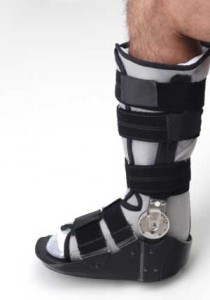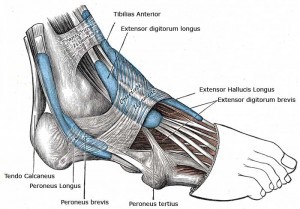Ankle sprains are very common injuries. They usually occur after a twisting injury of the ankle (most commonly, the ankle rolls inwards). The term “sprain” typically refers to injury to a ligament. Ligaments typically connect bones to other bones. Depending on the severity of injury, the ligament can be stretched, partially torn, or completely torn.
While specific treatment largely depends on the severity of the sprain, if treated quickly and properly, ankle sprains can heal well, allowing a safe and early return to your activities. If more severe sprains are not appropriately treated, they can become a chronic problem if they are not allowed to completely heal.
There are factors that increase your risks for ankle sprains:
- Previous ankle injuries
- Weak or unbalanced muscles
- Shoes that are worn out or are not the right shoes for the activity you’re doing
- Being overweight
- Family tendency
Ankle sprains most commonly occur on uneven surfaces that may cause the ankle to roll inwards—called ankle inversion. This sudden stress on the ligaments can result in a stretching or tearing of the ligaments on the outside of the ankle (most commonly, the lateral or outer ankle ligaments). At the time of the injury, an audible pop or snap in the ankle joint may be heard or felt. Following this, onset of pain may be immediate. Due to pain and instability, walking may be difficult. Within a few hours, the ankle can become bruised and swollen.
Basic Ankle Anatomy
A ligament is made up of fibrous tissue that is strong yet flexible. As is seen in other, the ligaments provide added stability to the joint. As discussed previously, a sprain is an injury to the ligaments. The lateral ligament complex—the ligaments that are on the lateral ankle (or outer part of the ankle)—are most commonly injured in a typical inversion injury of the ankle.
There are three main ligaments that make up the lateral ligament complex:
- the anterior talofibular ligament (ATFL)
- the calcaneofibular ligament (CFL)
- the posterior talofibular ligament (PTFL)
Please reference the following link for a better understanding of your foot and ankle anatomy and function.
Symptoms of an Ankle Sprain
During the initial injury, you may feel an associated pop or snap within the ankle joint. Immediately following this, your ankle may become painful and you may find it difficult to put weight on the ankle. Within a few hours, the ankle can become bruised and swollen. The latter is caused by ruptured blood vessels when the soft tissues tear. Swelling may continue to worsen over the next 1-2 days.
Diagnosis of an Ankle Sprain
Early diagnosis and treatment are important in the care of ankle sprains. The diagnosis of an ankle sprain begins with your doctor asking you questions about how the injury occurred and any symptoms that you are having. Your doctor will perform an examination of your ankle to give him/her clues regarding your injury. Additionally, plain X-rays may be ordered to make sure that there is no associated bony injury.
Ankle sprains are subcategorized into three grades of severity. The more severe the sprain, the longer it takes for the ligaments to recover.
- Grade I Sprain: In this injury type, ligaments of the ankle are mildly stretched. This is the most common injury type. There is little swelling and no instability in the ankle. With this degree of injury you can expect to be back to normal activities within a week or two.
- Grade II Sprain: Here, the ligaments are significantly stretched and may even be partially torn, and as such, the ankle usually swells right away. A grade II sprain may require a few weeks of bracing and physical therapy before you can return to full activity.
- Grade III Sprain: This is a more severe injury. The ligaments are torn. That being said, surgery is rarely required and a few weeks of bracing and physical therapy may be all that it takes for you to get back to normal activity.
Although uncommon, if you have persistent pain past 2-3 months, a MRI may be ordered to further evaluate the health of the ankle and to determine if there are any additional associated injuries.
Treatment for an Ankle Sprain
Ankle sprains are the most common fitness or sports related injury. If not properly treated, they can result in long-term pain, swelling, instability, and may limit your ability to participate in normal activities.
Treatment should begin immediately after the injury happens—even before you see a doctor. RICE therapy definitely applies to the treatment of ankle sprains. The goal of RICE therapy is to control pain, swelling and to limit weight bearing. See a doctor for your ankle injury as soon as you can.
- REST: In the first few days following an injury, let your ankle rest.
- ICE packs control swelling and help with pain control. Apply ice for 15-20 minutes every 2-3 hours.
- Gentle COMPRESSION with an elastic wrap (Ace bandage) will help to control swelling
- ELEVATION of your ankle above the level of your heart will help to control decrease swelling.
An example of treatment progression is as follows:
First few days to a week- To reduce swelling, apply RICE therapy to your ankle as outlined above. Depending on the grade of your sprain, your doctor may also recommend a brief period of non-weight bearing in the injured ankle. Your doctor may additionally recommend anti-inflammatories to help ease your pain
1 week onwards – In most cases, except for the most severe sprains, you can walk as soon as it’s comfortable for you. Even with the most severe sprains, you should be able to start putting weight on the ankle at this point. Use pain as your guide as to determine how much activity you can do. To prevent stiffness, range of motion exercises should be started at this point in the recovery process.
- Range-of-Motion Exercises: As healing starts, it is important to begin a series of range-of-motion (ROM) exercises. To start, you’ll work on bending and straightening your ankle and progress to diagonal motions.
In more severe injuries, the recovery process may take longer. A more gradual return to activity and sport with more rigorous formal physical therapy aimed at improving both flexibility of the ankle and strength of ankle stabilizing muscles may be warranted.
- Strengthening exercises: Strengthening exercises for the muscles around the ankle usually emphasize the muscles that pull the foot up and out (evertors), up (dorsiflexors), and down (plantarflexors). Isometric exercises may be used in the early stages of rehab. Isometric exercises are ones that require muscle activation while the joint doesn’t move. These exercises reduce overall pain and swelling and also help the muscles remember how they’re supposed work. Exercises that promote balance are also very important after a ligament injury. Healthy ligaments tell our brain what our joint is doing. This is how we are able to walk and move even with our eyes closed. When a ligament has been injured, these position receptors may be damaged, potentially increasing the likelihood of another injury. Balance exercises help restore our sense of position. Examples of these exercises include: standing and walking on uneven or very soft surfaces, balancing on one leg, and agility drills.
It is important to emphasize that a gradual progression to a full return to activities is key to the recovery process. More intensive exercises are added as the pain and irritation in your ankle start to improve. Progressive resistive exercises are exercises for the leg and ankle muscles in which the amount of weight being used is gradually increased. Closed-chain exercises are the staple to early rehabilitation. They allow the ankle to be exercised while easing stress on the ligaments. Examples of these types of exercises include a partial squat, weight shifting, step ups/downs, single leg balance, and lunges. These exercises are ideal as they mimic many of the activities we do on a day to day basis. If you are trying to prepare your ankle to return to a specific sport or rigorous type of work, then more advanced exercises like agility drills, plyometrics, and heavy resistance training may be useful.
Finally, returning to sporting activities too soon following an ankle injury can result in a re-injury. This can potentially become a chronic problem. Be sure to check with both your doctor and/or physical therapist prior to returning to sporting activities.
Ankle Instability
Although uncommon, sometimes the ligaments will not heal properly following injury. This can result in continued instability of the ankle. The ankle may easily give way or become easily re-injured. Ankle instability can lead to an ankle that is sore and painful, sometimes swollen, and unstable on uneven ground.
There are several treatment options for chronic ankle instability. A physical therapy program can help strengthen the muscles around the ankle to help make your ankle feel more stable. The use of various ankle braces can also help to stabilize the ankle. If all else fails, surgery may be an option.
Surgery to Repair Ligaments

If the ankle is still significantly bothersome after a prolonged period of non-surgical treatments, in the right situations, surgery may be an option to reconstruct the torn ligament. Surgery usually involves making an incision on the injured side of the ankle and reconstruction of the torn ligaments with synthetic material or your own tendon, transferred from elsewhere. After surgery, you will likely be in a cast or brace for a period of time to let the reconstructed ankle heal. After the cast is removed, physical therapy will begin to help you regain full use of your ankle.
Rehabilitation Exercises
Whether or not surgery is performed, well-timed physical therapy is perhaps the single most important treatment of ankle sprains and has been shown to speed healing of your ankle.

